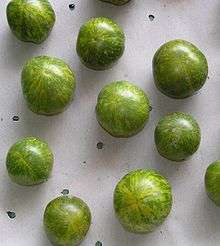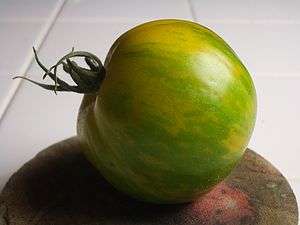Green Zebra
| Green Zebra | |
|---|---|
|
Green Zebra | |
| Tomato (Solanum lycopersicum) | |
| Type | Open pollinated |
| Vine | Indeterminate |
| Plant height | 9 feet |
| Fruit Weight | 6 oz |
| Leaf | Regular leaf |
| Color | Bicolor: Green with yellow stripes |
| Shape | Globe |

Green Zebra is a tomato cultivar with characteristic dark green and yellow stripes.[1] Newer variations blush reddish instead of yellow when ripe. It is more tart (described as 'spicy' and 'zingy')[2] than regular tomatoes, and it is an early cultivar. Compared to other tomato varieties, it can produce somewhat mealy fruits depending on growing conditions.
Green Zebra was bred by Tom Wagner of Everett, Washington, and introduced in his Tater-Mater Seed Catalog in 1983.[3] He first came up with the idea in the 1950s. Commonly, a green tomato meant it wasn’t ripe and they were normally thrown out. However, he was intrigued by the idea of a green tomato that was ready to eat.
There is some controversy as to whether Green Zebra should be considered an heirloom tomato. Some people don't consider it an heirloom quite yet,[3] while others consider it either an heirloom, "modern heirloom" or "created heirloom'.[4][5][6]
Classification
Common varieties include Green Zebra, Black Zebra, Big Zebra, and Red Zebra.
Planting information
The Green Zebra tomato does not often obtain a disease; however, if the tomato has a disease the Green Zebra will not turn yellow, the plant will stay green until it wilts. The Green Zebra has a higher defense rate against diseases compared to other tomatoes. To grow this tomato one must plant seed 1–2 weeks after the temperature remains constant around 60–95 degrees Fahrenheit. The soil should be well drained and the seed must remain 1/8 inch deep within the ground under full sunlight. Plant the seed 12 to 36 inches apart and let harvest for 65–80 days. This plant is semi-annual and it is best to harvest in midsummer. One should transplant when plant is 6 inches high.
Determining ripeness
Because the original color of this tomato is green it can be difficult to tell when it is ripe. There are three main ways to decipher when Green Zebra tomatoes are ready to eat. First, one can grasp the tomato gently to feel for firmness. Secondly, one can tell by looking at when the Zebra’s light green stripes turn to yellow. Thirdly, one can look at when the bottom of the yellow stripes begin to turn a blush color. Each of these stages represents a different ripening stage, so one must decide which stage of ripeness one prefers. Additionally, for a sweeter tomato leave it on the vine for a longer period of time. However, leaving it on the vine for too long can cause it to become mealy.
See also
- List of tomato cultivars
-
 Media related to Zebra tomatoes at Wikimedia Commons
Media related to Zebra tomatoes at Wikimedia Commons
References
- ↑ O'Neill, Molly (June 3, 1998). "What's Green And Has Stripes? A Zebra Tomato". New York Times. Retrieved August 26, 2012.
- ↑ "Green Zebra Tomato". Golden Harvest Organics. Retrieved August 26, 2012.
- 1 2 "Green Zebra Tomato". Tomato Dirt. Retrieved August 26, 2012.
- ↑ Borrell, Brendan. "How to Grow a Better Tomato: The Case against Heirloom Tomatoes". Scientific America. Retrieved 25 July 2013.
- ↑ Ibsen, Gary. "What Is An Heirloom Tomato?". Tomatofest. Retrieved 25 July 2013.
- ↑ Torgrimson, John. "GENEWATCH THE LIVING LEGACY". Council for responsible genetics. Retrieved 25 July 2013.
